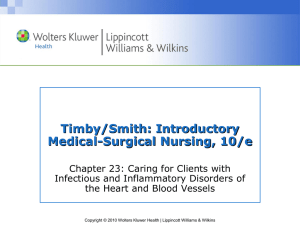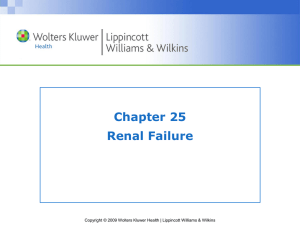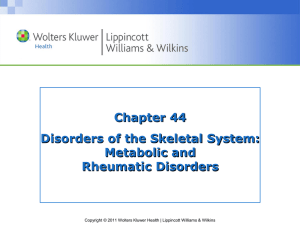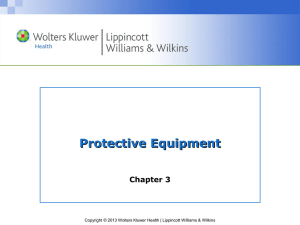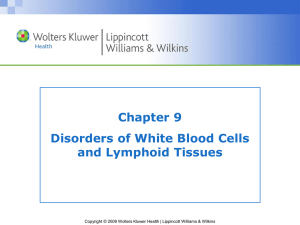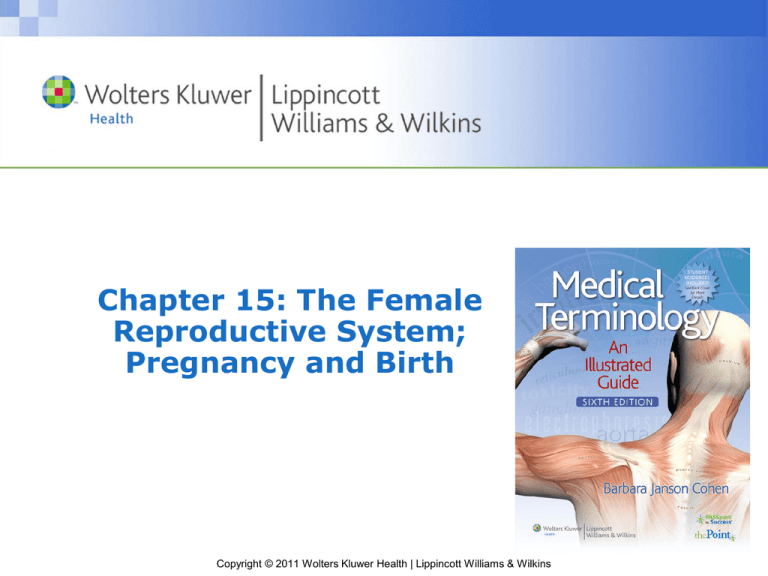
Chapter 15: The Female
Reproductive System;
Pregnancy and Birth
Copyright © 2011 Wolters Kluwer Health | Lippincott Williams & Wilkins
Chapter Objectives
Female reproductive tract and describe the function of each part.
Structure and function of the mammary glands.
Menstrual cycle.
Main disorders of the female reproductive system.
Major events that occur in the first 2 months after fertilization.
Structure and function of the placenta.
The three stages of childbirth.
Hormonal and nervous controls over lactation.
Roots pertaining to the female reproductive system, pregnancy & birth.
Abbreviations used in referring to reproduction.
Copyright © 2011 Wolters Kluwer Health | Lippincott Williams & Wilkins
Key Terms
Female Reproductive System
Normal Structure and Function
cervix
Neck. Usually means the lower narrow portion (neck) of the uterus
(root: cervic/o); cervix uteri (U-ter-ī)
clitoris
A small erectile body anterior to the urethral opening that is similar in
origin to the penis (root: clitor/o, clitorid/o)
contraception
The prevention of pregnancy
corpus luteum
The small yellow structure that develops from the graafian follicle after
ovulation and secretes progesterone and estrogen
cul-de-sac
A blind pouch, such as the recess between the rectum and the uterus;
the rectouterine pouch or pouch of Douglas
endometrium
The inner lining of the uterus
estrogen
A group of hormones that produce female characteristics and prepare
the uterus for the fertilized egg. The most active of these is estradiol
fallopian tube
See oviduct
Copyright © 2011 Wolters Kluwer Health | Lippincott Williams & Wilkins
Key Terms
Female Reproductive System
Normal Structure and Function (cont’d)
fimbriae
The long fingerlike extensions of the oviduct that wave to capture
the released ovum (singular: fimbria)
follicle-stimulating
hormone (FSH)
A hormone secreted by the anterior pituitary that acts on the
gonads. In the female, it stimulates ripening of the ova in the ovary
fornix
An archlike space, such as the space between the uppermost wall
of the vagina and the cervix; from Latin meaning “arch”
graafian follicle
See ovarian follicle
labia majora
The two large folds of skin that form the sides of the vulva (root
labi/o means “lip”) (singular: labium majus)
labia minora
The two small folds of skin within the labia majora (singular: labium
minus)
luteinizing hormone
(LH)
A hormone secreted by the anterior pituitary that acts on the
gonads. In the female, it stimulates ovulation and formation of the
corpus luteum
Copyright © 2011 Wolters Kluwer Health | Lippincott Williams & Wilkins
Key Terms
Female Reproductive System
Normal Structure and Function (cont’d)
mammary gland
A specialized gland capable of secreting milk in the female; the
breast (root: mamm/o, mast/o)
menarche
The first menstrual period, which normally occurs during puberty
menopause
Cessation of menstrual cycles in the female
menstruation
The cyclic discharge of blood and mucosal tissues from the lining of
the nonpregnant uterus (root: men/o, mens); menstrual period,
menses (MEN-sez)
myometrium
The muscular wall of the uterus
ovarian follicle
The cluster of cells in which the ovum ripens in the ovary. Also
called graafian (GRAF-ē-an) follicle
ovary
A female gonad (root: ovari/o, oophor/o)
oviduct
A tube extending from the upper lateral portion of the uterus that
carries the ovum to the uterus (root: salping/o). Also called fallopian
(fa-LŌ-pē-an) or uterine tube
Copyright © 2011 Wolters Kluwer Health | Lippincott Williams & Wilkins
Key Terms
Female Reproductive System
Normal Structure and Function (cont’d)
ovulation
The release of a mature ovum from the ovary (from ovule, meaning
“little egg”)
ovum
The female gamete or reproductive cell (plural: ova) (root: oo, ov/o)
perineum
The region between the thighs from the external genitals to the anus
(root: perine/o)
progesterone
A hormone produced by the corpus luteum and the placenta that
maintains the endometrium for pregnancy
tubal ligation
Surgical constriction of the oviducts to produce sterilization
uterus
The organ that receives the fertilized egg and maintains the
developing offspring during pregnancy (root: uter/o, metr, hyster/o)
vagina
The muscular tube between the cervix and the vulva (root: vagin/o,
colp/o)
vulva
The external female genital organs (root: vulv/o, episi/o)
Copyright © 2011 Wolters Kluwer Health | Lippincott Williams & Wilkins
Key Terms
Female Reproductive System Disorders
candidiasis
Infection with the fungus Candida, a common cause of vaginitis
dysmenorrheal
Painful or difficult menstruation. A common disorder that may be
caused by infection, use of an intrauterine device, endometriosis,
overproduction of prostaglandins, or other factors
endometriosis
Growth of endometrial tissue outside the uterus, usually in the pelvic
cavity
fibroid
Benign tumor of smooth muscle (see leiomyoma)
leiomyoma
Benign tumor of smooth muscle, usually in the uterine wall
(myometrium). In the uterus, may cause bleeding and pressure on the
bladder or rectum. Also called fibroid or myoma
Copyright © 2011 Wolters Kluwer Health | Lippincott Williams & Wilkins
Key Terms
Female Reproductive System Disorders (cont’d)
pelvic
inflammatory
disease (PID)
Condition caused by the spread of infection from the reproductive tract
into the pelvic cavity. Commonly caused by sexually transmitted
gonorrhea and chlamydial infections
salpingitis
Inflammation of the oviduct; typically caused by urinary tract infection or
sexually transmitted infection. Chronic salpingitis may lead to infertility
or ectopic pregnancy (development of the fertilized egg outside of the
uterus)
vaginitis
Inflammation of the vagina
Copyright © 2011 Wolters Kluwer Health | Lippincott Williams & Wilkins
Key Terms
Female Reproductive System
Diagnosis and Treatment
colposcope
Instrument for examining the vagina and cervix
cone biopsy
Removal of a cone of tissue from the lining of the cervix for cytologic
examination; also called conization
dilation and
curettage (D&C)
Procedure in which the cervix is dilated (widened) and the uterine
lining is scraped with a curette
hysterectomy
Surgical removal of the uterus. Most commonly done because of
tumors. Often the oviducts and ovaries are removed as well
mammography
Radiographic study of the breast for the detection of breast cancer
mastectomy
Excision of the breast to eliminate malignancy
Copyright © 2011 Wolters Kluwer Health | Lippincott Williams & Wilkins
Key Terms
Female Reproductive System
Diagnosis and Treatment (cont’d)
oophorectomy
Excision of an ovary
Pap smear
Study of cells collected from the cervix and vagina for early
detection of cancer. Also called Papanicolaou smear or Pap test.
salpingectomy
Surgical removal of the oviduct
sentinel-node biopsy
Biopsy of the first lymph nodes to receive drainage from a tumor;
used to determine spread of cancer in planning treatment.
stereotactic biopsy
Needle biopsy using a computer-guided imaging system to locate
suspicious tissue and remove samples for study
Copyright © 2011 Wolters Kluwer Health | Lippincott Williams & Wilkins
Supplementary Terms
Female Reproductive System
Normal Structure and Function
adnexa
Appendages, such as the adnexa uteri—the ovaries, oviducts, and
uterine ligaments
areola
A pigmented ring, such as the dark area around the nipple of the
breast
greater vestibular
gland
A small mucus-secreting gland on the side of the vestibule (see
below) near the vaginal opening. Also called Bartholin (BAR-tō-lin)
gland
hymen
A fold of mucous membrane that partially covers the entrance of the
vagina
mons pubis
The rounded, fleshy elevation anterior to the pubic joint that is covered
with hair after puberty
Copyright © 2011 Wolters Kluwer Health | Lippincott Williams & Wilkins
Supplementary Terms
Female Reproductive System
Normal Structure and Function (cont’d)
oocyte
An immature ovum
perimenopause
The period immediately before and after menopause; begins at the
time of irregular menstrual cycles and ends 1 year after the last
menstrual period; averages 3 to 4 years
vestibule
The space between the labia minora that contains the openings of
the urethra, vagina, and ducts of the greater vestibular glands
Copyright © 2011 Wolters Kluwer Health | Lippincott Williams & Wilkins
Supplementary Terms
Female Reproductive System
Disorders
cystocele
Herniation of the urinary bladder into the wall of the vagina
dyspareunia
Pain during sexual intercourse
fibrocystic disease of
the breast
A condition in which there are palpable lumps in the breasts,
usually associated with pain and tenderness. These lumps or
“thickenings” change with the menstrual cycle and must be
distinguished from malignant tumors by diagnostic methods
hirsutism
Excess growth of hair
Copyright © 2011 Wolters Kluwer Health | Lippincott Williams & Wilkins
Supplementary Terms
Female Reproductive System
Disorders (cont’d)
leucorrhea
White or yellowish discharge from the vagina. Infection and other
disorders may change the amount, color, or odor of the discharge
microcalcification
Small deposit of calcium that appears as a white spot on
mammograms. Most microcalcifications are harmless, but some
might indicate breast cancer
prolapse of the
uterus
Downward displacement of the uterus with the cervix sometimes
protruding from the vagina
rectocele
Herniation of the rectum into the wall of the vagina; also called
proctocele
Copyright © 2011 Wolters Kluwer Health | Lippincott Williams & Wilkins
Supplementary Terms
Female Reproductive System
Diagnosis and Treatment
culdocentesis
Puncture of the vaginal wall to sample fluid from the rectouterine
space for diagnosis
episiorrhaphy
Suture of the vulva or suture of the perineum cut in an episiotomy
(incision to ease childbirth)
laparoscopy
Endoscopic examination of the abdomen; may include surgical
procedures, such as tubal ligation
myomectomy
Surgical removal of a uterine leiomyoma (fibroid, myoma)
speculum
An instrument used to enlarge the opening of a passage or cavity to
allow examination
teletherapy
Delivery of radiation to a tumor from an external beam source, as
compared to implantation of radioactive material (brachytherapy) or
systemic administration of radionuclide
Copyright © 2011 Wolters Kluwer Health | Lippincott Williams & Wilkins
Supplementary Terms
Female Reproductive System
Drugs
aromatase inhibitor
(AI)
Agent that inhibits estrogen production; used for postmenopausal
treatment of breast cancers that respond to estrogen. Examples are
exemestane (Aromasin), anastrozole (Arimidex), letrozole (Femara)
bisphosphonate
Agent used to prevent and treat osteoporosis; increases bone mass
by decreasing bone turnover. Examples are alendronate (Fosamax)
and risedronate (Actonel)
HER2 inhibitor
Drug used to treat breast cancers that show excess receptors
(HER2) for human epidermal growth factor. Example is trastuzumab
(Herceptin)
paclitaxel
Antineoplastic agent derived from yew trees used mainly in treatment
of breast and ovarian cancer; Taxol
selective estrogen
receptor modulator
(SERM)
Drug that acts on estrogen receptors. Examples are tamoxifen
(Nolvadex) and raloxifene (Evista), which is also used to prevent
bone loss after menopause
Copyright © 2011 Wolters Kluwer Health | Lippincott Williams & Wilkins
Abbreviations
Female Reproductive System
AI
Aromatase inhibitor
BRCA1
Breast cancer gene 1
BRCA2
Breast cancer gene 2
BSE
Breast self-examination
BSO
Bilateral salpingo-oophorectomy
BV
Bacterial vaginosis
CIN
Cervical intraepithelial neoplasia
D&C
Dilation and curettage
DCIS
Ductal carcinoma in situ
DES
Diethylstilbestrol
Copyright © 2011 Wolters Kluwer Health | Lippincott Williams & Wilkins
Abbreviations
Female Reproductive System (cont’d)
DUB
Dysfunctional uterine bleeding
FSH
Follicle-stimulating hormone
GC
Gonococcus (cause of gonorrhea)
GYN
Gynecology
HPV
Human papillomavirus
HRT
Hormone-replacement therapy
IUD
Intrauterine device
LH
Luteinizing hormone
NGU
Nongonococcal urethritis
PCOS
Polycystic ovarian syndrome
Copyright © 2011 Wolters Kluwer Health | Lippincott Williams & Wilkins
Abbreviations
Female Reproductive System (cont’d)
PID
Pelvic inflammatory disease
PMS
Premenstrual syndrome
SERM
Selective estrogen receptor modulator
STD
Sexually transmitted disease
STI
Sexually transmitted infection
TAH
Total abdominal hysterectomy
TSS
Toxic shock syndrome
UFE
Uterine fibroid embolization
VD
Venereal disease (sexually transmitted disease)
Copyright © 2011 Wolters Kluwer Health | Lippincott Williams & Wilkins
Female Reproductive System
• Ovaries are female gonads
• Held by ligaments in pelvic cavity
• Ova (eggs) develop inside
• At ovulation one ovum released from ovary
• Follicle remains behind
– If no fertilization, functions for two weeks
– If fertilization, functions for two months
Copyright © 2011 Wolters Kluwer Health | Lippincott Williams & Wilkins
Female Reproductive System
Copyright © 2011 Wolters Kluwer Health | Lippincott Williams & Wilkins
Oviducts and Uterus
• After ovulation, ovum moves into one oviduct (tube)
– Attached to upper lateral portion of uterus
– Arches above ovary
– Fingerlike projections (fimbriae) sweep released ovum into
oviduct
• Uterus is pear-shaped organ that nourishes fetus
– Upper rounded fundus
– Triangular cavity
– Lower narrow cervix
Copyright © 2011 Wolters Kluwer Health | Lippincott Williams & Wilkins
Oviducts and Uterus (cont’d)
– Endometrium
• Innermost layer of uterine wall
• Rich blood supply
• Receives fertilized ovum
• Becomes part of placenta if pregnancy occurs
• If no fertilization, endometrium is shed during menstrual
period
– Myometrium
• Muscle layer of uterine wall
Copyright © 2011 Wolters Kluwer Health | Lippincott Williams & Wilkins
Vagina
• Muscular tube
• Functions:
– Transports menstrual flow from body
– Receives penis during intercourse
– Acts as birth canal
Copyright © 2011 Wolters Kluwer Health | Lippincott Williams & Wilkins
External Genital Organs
• Collectively known as vulva
– Includes:
• Labia majora
• Labia minora
• Clitoris
Copyright © 2011 Wolters Kluwer Health | Lippincott Williams & Wilkins
External Genital Organs (cont’d)
• Perineum
– Region between thighs from external genital organs
to anus
– Episiotomy procedure
• Facilitates childbirth
• Prevents tearing of tissue
• Technically perineotomy
• Because root episi/o means “vulva”
Copyright © 2011 Wolters Kluwer Health | Lippincott Williams & Wilkins
External Genital Organs
Copyright © 2011 Wolters Kluwer Health | Lippincott Williams & Wilkins
Mammary Glands
• Commonly known as breasts
• Composed of:
–
Glandular tissue
–
Fat
• Function:
–
Provide nourishment to newborn
• Milk:
–
Secreted by glands
–
Carried in ducts to nipple
Copyright © 2011 Wolters Kluwer Health | Lippincott Williams & Wilkins
Menstrual Cycle
• Starts with menarche
• Controlled by anterior pituitary gland
• FSH begins cycle
– Ovum ripens in graafian follicle
• Follicle secrets estrogen
– Hormone prepares endometrium for egg
• LH (luteinizing hormone)
– Triggers ovulation and conversion of follicle to corpus
luteum
Copyright © 2011 Wolters Kluwer Health | Lippincott Williams & Wilkins
Menstrual Cycle (cont’d)
• Corpus luteum
– Remains in ovary
– Secretes progesterone and estrogen
• If no fertilization:
– Hormone levels decline
– Endometrium is released in menstruation
• Average cycle 28 days
– Ovulation occurs about day 14
Copyright © 2011 Wolters Kluwer Health | Lippincott Williams & Wilkins
Menopause
• End of monthly menstrual cycles
–
Usually occurs between 45 and 55
–
Hormone levels decline
–
Egg cells degenerate
• Possible symptoms:
–
Hot flashes
–
Headaches
–
Insomnia
–
Mood swings
–
Urinary problems
–
Vaginal dryness
Copyright © 2011 Wolters Kluwer Health | Lippincott Williams & Wilkins
Menopause (cont’d)
• Used to alleviate symptoms:
– Hormone-replacement therapy
– Antidepressants
– Vitamin E
Copyright © 2011 Wolters Kluwer Health | Lippincott Williams & Wilkins
Contraception
• Prevention of fertilization of ovum by:
– Stopping sperm penetration
– Preventing implantation of fertilized egg
– Preventing ovulation
• Sterilization by:
– Vasectomy (Male)
– Tubal ligation (Female)
Copyright © 2011 Wolters Kluwer Health | Lippincott Williams & Wilkins
Sterilization
Copyright © 2011 Wolters Kluwer Health | Lippincott Williams & Wilkins
Clinical Aspects of Female Reproduction
• Infections
–
Genital herpes
–
Vaginitis
–
Pelvic Inflammatory Disease
–
Salpingitis
• Fibroids
–
Cause heavy menstrual bleeding and rectal or bladder pressure
Copyright © 2011 Wolters Kluwer Health | Lippincott Williams & Wilkins
Clinical Aspects of Female Reproduction
(cont’d)
• Endometriosis
–
Growth of endometrial tissue outside of uterus
–
Causes: inflammation, fibrosis, adhesions
–
Results in pain, dysmenorrhea, infertility
–
Laparoscopy for diagnosis or to remove abnormal tissue
Copyright © 2011 Wolters Kluwer Health | Lippincott Williams & Wilkins
Menstrual Disorders
• Dysfunctional uterine bleeding
–
Oligomenorrhea (too light flow)
–
Menorrhagia (too heavy flow)
–
Amenorrhea (absence of monthly flow)
–
Dysmenorrhea (painful, difficult menstruation)
• Caused by:
–
Hormone imbalances
–
Systemic disorders
–
Uterine problems
Copyright © 2011 Wolters Kluwer Health | Lippincott Williams & Wilkins
Menstrual Disorders (cont’d)
• More common in adolescence or near menopause
• Premenstrual syndrome (PMS)
–
Describes symptoms appearing in 2nd half of cycle
–
Symptoms: emotional changes, fatigue, bloating, headaches,
appetite changes
–
Possible symptom relief: hormone therapy, antidepressants,
antianxiety medications, exercise, dietary control, rest,
relaxation
Copyright © 2011 Wolters Kluwer Health | Lippincott Williams & Wilkins
Polycystic Ovarian Syndrome
• Endocrine disorder
–
Increased androgen and estrogen secretions
–
Interferes with normal FSH and LH secretion
• Effects:
–
Anovulation and infertility
–
Scant or absent menses
–
Excessive hair growth
–
Resistance to insulin
–
Obesity
Copyright © 2011 Wolters Kluwer Health | Lippincott Williams & Wilkins
Polycystic Ovarian Syndrome (cont’d)
• Treated with:
–
Hormones
–
Drugs
–
Weight reduction
–
Partial removal of ovary
Copyright © 2011 Wolters Kluwer Health | Lippincott Williams & Wilkins
Cancer of Female Reproductive Tract
• Endometrial cancer
– Most common female reproductive cancer
– Not always detected by Pap smear
– Treatment with:
• Hysterectomy
• Radiation therapy
Copyright © 2011 Wolters Kluwer Health | Lippincott Williams & Wilkins
Cancer of Female Reproductive Tract
(cont’d)
• Cervical cancer
– Almost all patients also have been infected with HPV
– Preceded by dysplasia of epithelial cells lining cervix
– Diagnosis with:
• Pap smear
• Colposcope exam
• Biopsy
Copyright © 2011 Wolters Kluwer Health | Lippincott Williams & Wilkins
Cancer of Female Reproductive Tract
(cont’d)
• Ovarian cancer
– No early symptoms
– High mortality rate
– Treatment
• Oophorectomy
• Salpingectomy
• Hysterectomy
• Chemotherapy
• Radiation therapy
Copyright © 2011 Wolters Kluwer Health | Lippincott Williams & Wilkins
Breast Cancer
• Second-leading cause of cancer-related deaths in U.S.
women
• Metastasizes rapidly via lymph nodes
– Ultrasound
• Diagnosed with mammography
– MRI
– Biopsy
Copyright © 2011 Wolters Kluwer Health | Lippincott Williams & Wilkins
Breast Cancer (cont’d)
• Treatment:
– Mastectomy (removal of breast)
– Radiation therapy
– Chemotherapy
– Hormone therapy
Copyright © 2011 Wolters Kluwer Health | Lippincott Williams & Wilkins
Roots for Female Reproduction and the
Ovaries
Root
Meaning
Example
Definition of Example
gyn/o, gynec/o*
woman
gynecology
study of women's diseases
men/o, mens
month,
menstruation
premenstrual
before a menstrual periods
oo
ovum, egg cell
oocyte
cell that gives rise to an
ovum
ov/o, ovul/o
ovum, egg cell
anovulatory
absence of egg ripening or
of ovulation
ovari/o
ovary
ovariopexy
surgical fixation of an ovary
oophor/o
ovary
oophorectomy
excision of an ovary
*This root may also be pronounced with a soft g, as in jin-e-KOL-ō-je
Copyright © 2011 Wolters Kluwer Health | Lippincott Williams & Wilkins
Roots for the Oviducts, Uterus, and
Vagina
Root
Meaning
Example
Definition of Example
salping/o
oviduct, tube
salpingoplasty
plastic repair of an oviduct
uter/o
uterus
intrauterine
within the uterus
metr/o, metr/i
uterus
metrorrhea
abnormal uterine discharge
hyster/o
uterus
hysterotomy
incision of the uterus
cervic/o
cervix, neck
endocervical
pertaining to the lining of the
cervix
vagin/o
vagina
vaginometer
instrument for measuring the
vagina
colp/o
vagina
colpostenosis
narrowing of the vagina
Copyright © 2011 Wolters Kluwer Health | Lippincott Williams & Wilkins
Roots for the Female Accessory Structures
Root
Meaning
Example
Definition of Example
vulv/o
vulva
vulvar
pertaining to the vulva
episi/o
vulva
episiotomy
incision of the vulva
perine/o
perineum
perineal
pertaining to the perineum
clitor/o,
clitorid/o
clitoris
clitorectomy
excision of the clitoris
mamm/o
breast,
mammary gland
mammoplasty
plastic surgery of the breast
mast/o
breast,
mammary gland
amastia
absence of the breasts
Copyright © 2011 Wolters Kluwer Health | Lippincott Williams & Wilkins
Key Terms
Pregnancy and Birth
Normal Structure and Function
amniotic sac
The membranous sac filled with fluid that holds the fetus; also called
amnion (root: amnio)
chorion
The outermost layer of the embryo that, with the endometrium, forms
the placenta (adjective: chorionic)
colostrum
Breast fluid that is secreted in the first few days after giving birth,
before milk is produced
ductus arteriosus
A fetal blood vessel that connects the pulmonary artery with the
descending aorta, thus allowing blood to bypass the lungs
embryo
The stage in development between the zygote and the fetus,
extending from the second through the eighth week of growth in the
uterus (root: embry/o); adjective: embryonic
fertilization
The union of an ovum and a spermatozoon
Copyright © 2011 Wolters Kluwer Health | Lippincott Williams & Wilkins
Key Terms
Pregnancy and Birth
Normal Structure and Function (cont’d)
fetus
The developing child in the uterus from the third month to birth (root:
fet/o); adjective: fetal
foramen ovale
A small hole in the intraatrial septum in the fetal heart that allows blood
to pass directly from the right to the left side of the heart
gestation
The period of development from conception to birth
gravida
Pregnant woman
human chorionic
gonadotropin
(hCG)
A hormone secreted by the embryo early in pregnancy that maintains
the corpus luteum so that it will continue to secrete hormones
lactation
The secretion of milk from the mammary glands
oxytocin
A pituitary hormone that stimulates contractions of the uterus. It also
stimulates release (“letdown”) of milk from the breasts
Copyright © 2011 Wolters Kluwer Health | Lippincott Williams & Wilkins
Key Terms
Pregnancy and Birth
Normal Structure and Function (cont’d)
para
Woman who has produced a viable infant. Multiple births are
considered as single pregnancies
parturition
Childbirth (root: nat/i); labor (root: toc/o)
placenta
The organ, composed of fetal and maternal tissues, that nourishes
and maintains the developing fetus
prostaglandins
A group of hormones with varied effects, including the stimulation of
uterine contractions
umbilical cord
The structure that connects the fetus to the placenta. It contains
vessels that carry blood between the mother and the fetus
zygote
The fertilized ovum
Copyright © 2011 Wolters Kluwer Health | Lippincott Williams & Wilkins
Key Terms
Pregnancy and Birth
Disorders
abortion
Termination of a pregnancy before the fetus is capable of surviving
outside the uterus, usually at 20 wk or 500 g. May be spontaneous or
induced. A spontaneous abortion is commonly called a miscarriag
anencephaly
Congenital absence of a brain
atresia
Congenital absence or closure of a normal body opening
carrier
An individual who has an unexpressed genetic defect that can be passed
to his or her children
cleft lip
A congenital separation of the upper lip
cleft palate
A congenital split in the roof of the mouth
congenital
disorder
A disorder that is present at birth. May be developmental or hereditary
(familial)
Copyright © 2011 Wolters Kluwer Health | Lippincott Williams & Wilkins
Key Terms
Pregnancy and Birth
Disorders (cont’d)
eclampsia
Convulsions and coma occurring during pregnancy or after delivery
and associated with the conditions of pregnancy-induced
hypertension (see below) (adjective: eclamptic)
ectopic pregnancy
Development of the fertilized ovum outside the body of the uterus.
Usually occurs in the oviduct (tubal pregnancy) but may occur in
other parts of the reproductive tract or abdominal cavity
hemolytic disease of
the newborn (HDN)
Disease that results from Rh incompatibility between the blood of a
mother and her fetus. An Rh-negative mother produces antibody to
Rh-positive fetal red cells that enter her circulation. These antibodies
can destroy Rh-positive fetal red cells in a later pregnancy unless the
mother is treated with antibodies to remove the Rh antigen. Formerly
called erythroblastosis fetalis
mastitis
Inflammation of the breast, usually associated with the early weeks
of breastfeeding
Copyright © 2011 Wolters Kluwer Health | Lippincott Williams & Wilkins
Key Terms
Pregnancy and Birth
Disorders (cont’d)
mutation
A change in the genetic material of the cell. Most mutations are
harmful. If the change appears in the sex cells, it can be passed to
future generations
placental abruption
Premature separation of the placenta; abruptio placentae
placenta previa
A placenta that is attached in the lower portion of the uterus instead
of the upper portion, as is normal. May result in hemorrhage late in
pregnancy.
pregnancy-induced
hypertension (PIH)
A toxic condition of late pregnancy associated with hypertension,
edema, and proteinuria that, if untreated, may lead to eclampsia.
Also called preeclampsia (prē-e-KLAMP-sē-a) and toxemia of
pregnancy
Copyright © 2011 Wolters Kluwer Health | Lippincott Williams & Wilkins
Key Terms
Pregnancy and Birth
Disorders (cont’d)
rubella
German measles. The virus can cross the placenta and cause fetal
abnormalities, such as eye defects, deafness, heart abnormalities,
and mental retardation. The virus is most damaging during the first
trimester.
spina bifida
A congenital defect in the closure of the spinal column through
which the spinal cord and its membranes may project
teratogen
A factor that causes developmental abnormalities in the fetus (root
terat/o means “malformed fetus”); adjective: teratogenic
Copyright © 2011 Wolters Kluwer Health | Lippincott Williams & Wilkins
Key Terms
Pregnancy and Birth
Diagnosis and Treatment
amniocentesis
Transabdominal puncture of the amniotic sac to remove amniotic
fluid for testing. Tests on the cells and fluid obtained can reveal
congenital abnormalities, blood incompatibility, and sex of the fetus
chorionic villus
sampling (CVS)
Removal of chorionic cells through the cervix for prenatal testing.
Can be done earlier in pregnancy than amniocentesis
dilatation and
evacuation (D&E)
Widening of the cervix and removal of conception products by
suction
karyotype
A picture of the chromosomes of a cell arranged in order of
decreasing size; can reveal abnormalities in the chromosomes
themselves or in their number or arrangement (root kary/o means
“nucleus”)
ultrasonography
The use of high-frequency sound waves to produce a photograph of
an organ or tissue. Used in obstetrics to diagnose pregnancy,
multiple births, and abnormalities and also to study and measure
the fetus. The picture obtained is a sonogram or ultrasonogram
Copyright © 2011 Wolters Kluwer Health | Lippincott Williams & Wilkins
Supplementary Terms
Pregnancy and Birth
Normal Structure and Function
afterbirth
The placenta and membranes delivered after birth of a child
antepartum
Before childbirth, with reference to the mother
Braxton–Hicks
contractions
Light uterine contractions that occur during pregnancy and increase in
frequency and intensity during the third trimester. They strengthen the
uterus for delivery
chloasma
Brownish pigmentation that appears on the face during pregnancy;
melasma
fontanel
A membrane-covered space between cranial bones in the fetus that
later becomes ossified; a soft spot. Also spelled fontanelle
intrapartum
Occurring during childbirth
Copyright © 2011 Wolters Kluwer Health | Lippincott Williams & Wilkins
Supplementary Terms
Pregnancy and Birth
Normal Structure and Function (cont’d)
linea nigra
A dark line on the abdomen from the umbilicus to the pubic region
that may appear late in pregnancy
lochia
The mixture of blood, mucus, and tissue discharged from the uterus
after childbirth
meconium
The first feces of the newborn
peripartum
Occurring during the end of pregnancy or the first few months after
delivery, with reference to the mother
postpartum
After childbirth, with reference to the mother
premature
Describing an infant born before the organ systems are fully
developed; immature
Copyright © 2011 Wolters Kluwer Health | Lippincott Williams & Wilkins
Supplementary Terms
Pregnancy and Birth
Normal Structure and Function (cont’d)
preterm
Occurring before the 37th week of gestation; describing an infant
born before the 37th week of gestation
puerperium
The first 42 days after childbirth, during which the mother's
reproductive organs usually return to normal (root: puer means
“child”)
striae atrophicae
Pinkish or gray lines that appear where skin has been stretched,
as in pregnancy; stretch marks, striae gravidarum
umbilicus
The scar in the middle of the abdomen that marks the attachment
point of the umbilical cord to the fetus; the navel
vernix caseosa
The cheeselike deposit that covers and protects the fetus (literally
“cheesy varnish”)
Copyright © 2011 Wolters Kluwer Health | Lippincott Williams & Wilkins
Supplementary Terms
Pregnancy and Birth - Disorders
cephalopelvic
disproportion
The condition in which the head of the fetus is larger than the pelvic
outlet; also called fetopelvic disproportion
choriocarcinoma
A rare malignant neoplasm composed of placental tissue
galactorrhea
Excessive secretion of milk or continuation of milk production after
breastfeeding has ceased. Often results from excess prolactin secretion
and may signal a pituitary tumor.
hydatidiform
mole
A benign overgrowth of placental tissue. The placenta dilates and
resembles grapelike cysts. The neoplasm may invade the wall of the
uterus, causing rupture. Also called hydatid mole.
hydramnios
An excess of amniotic fluid; also called polyhydramnios
oligohydramnios
A deficiency of amniotic fluid
patent ductus
arteriosus (PDA)
Persistence of the ductus arteriosus after birth so that blood continues to
shunt from the pulmonary artery to the aorta
puerperal
infection
Infection of the genital tract after delivery
Copyright © 2011 Wolters Kluwer Health | Lippincott Williams & Wilkins
Supplementary Terms
Pregnancy and Birth
Diagnosis and Treatment
abortifacient
Agent that induces abortion
alphafetoprotein
(AFP)
A fetal protein that may be elevated in amniotic fluid and maternal serum
in cases of certain fetal disorders
Apgar score
A system of rating an infant's physical condition immediately after birth.
Five features are rated as 0, 1, or 2 at 1 minute and 5 minutes after
delivery, and sometimes thereafter. The maximum possible score at each
interval is 10. Infants with low scores require medical attention
artificial
insemination
(AI)
Placement of active semen into the vagina or cervix for the purpose of
impregnation. The semen can be from a husband, partner, or donor
cesarean
section
Incision of the abdominal wall and uterus for delivery of a fetus
culdocentesis
Puncture of the vaginal wall to sample fluid from the rectouterine space
for diagnosis
Copyright © 2011 Wolters Kluwer Health | Lippincott Williams & Wilkins
Supplementary Terms
Pregnancy and Birth
Diagnosis and Treatment (cont’d)
endometrial
ablation
Selective destruction of the endometrium for therapeutic purpose;
done to relieve excessive menstrual bleeding (menorrhagia)
extracorporeal
membrane
oxygenation
(ECMO)
A technique for pulmonary bypass in which deoxygenated blood is
removed, passed through a circuit that oxygenates the blood, and
then returned. Used for selected newborn and pediatric patients in
respiratory failure with an otherwise good prognosis.
in vitro fertilization
(IVF)
Clinical procedure for achieving fertilization when it cannot be
accomplished naturally. An oocyte (immature ovum) is removed,
fertilized in the laboratory, and placed as a zygote into the uterus or
fallopian tube (ZIFT, zygote intrafallopian transfer). Alternatively, an
ovum can be removed and placed along with sperm cells into the
fallopian tube (GIFT, gamete intrafallopian transfer).
obstetrics
The branch of medicine that treats women during pregnancy,
childbirth, and the puerperium. Usually combined with the practice of
gynecology.
Copyright © 2011 Wolters Kluwer Health | Lippincott Williams & Wilkins
Supplementary Terms
Pregnancy and Birth
Diagnosis and Treatment (cont’d)
pediatrics
The branch of medicine that treats children and diseases of children
(root: ped/o means “child”)
pelvimetry
Measurement of the pelvis by manual examination or radiographic
study to determine whether delivery of a fetus through the vagina will
be possible
Pitocin
Trade name for oxytocin; used to induce and hasten labor
presentation
Term describing the part of the fetus that can be felt by vaginal or
rectal examination. Normally the head presents first (vertex
presentation), but sometimes the buttocks (breech presentation),
face, or other part presents first
Rho-GAM
Trade name for a preparation of antibody to the Rh(D) antigen; used
to prevent hemolytic disease of the newborn in cases of Rh
incompatibility
Copyright © 2011 Wolters Kluwer Health | Lippincott Williams & Wilkins
Abbreviations
Pregnancy and Birth
AB
Abortion
AFP
Alpha-fetoprotein
AGA
Appropriate for gestational age
AI
Artificial insemination
ART
Assisted reproductive technology
C-section
Cesarean section
CPD
Cephalopelvic disproportion
CVS
Chorionic villus sampling
D&E
Dilatation and evacuation
ECMO
Extracorporeal membrane oxygenation
EDC
Estimated date of confinement
Copyright © 2011 Wolters Kluwer Health | Lippincott Williams & Wilkins
Abbreviations
Pregnancy and Birth (cont’d)
FHR
Fetal heart rate
FHT
Fetal heart tone
FTND
Full-term normal delivery
FTP
Full-term pregnancy
GA
Gestational age
GIFT
Gamete intrafallopian transfer
hCG
Human chorionic gonadotropin
HDN
Hemolytic disease of the newborn
IVF
In vitro fertilization
LMP
Last menstrual period
NB
Newborn
Copyright © 2011 Wolters Kluwer Health | Lippincott Williams & Wilkins
Abbreviations
Pregnancy and Birth (cont’d)
NICU
Neonatal intensive care unit
OB
Obstetrics
PDA
Patent ductus arteriosus
PIH
Pregnancy-induced hypertension
PKU
Phenylketonuria
SVD
Spontaneous vaginal delivery
UC
Uterine contractions
UTP
Uterine term pregnancy
VBAC
Vaginal birth after cesarean section
ZIFT
Zygote intrafallopian transfer
Copyright © 2011 Wolters Kluwer Health | Lippincott Williams & Wilkins
Roots Pertaining to Pregnancy and Birth
Root
Meaning
Example
Definition of Example
amnio
amnion, amniotic
sac
diamniotic
showing two amniotic sacs
embry/o
embryo
embryonic
pertaining to the embryo
fet/o
fetus
fetometry
measurement of a fetus
toc/o
labor
dystocia
difficult labor
nat/i
birth
neonate
Newborn
lact/o
milk
lactose
sugar (-ose) found in milk
galact/o
milk
galactogogue
agent that promotes (-agogue)
the flow of milk
gravida
pregnant woman
nulligravida
woman who has never (nulli-)
been pregnant
para
woman who has
given birth
multipara
woman who has given birth two
or more times
Copyright © 2011 Wolters Kluwer Health | Lippincott Williams & Wilkins
Fertilization
• Sperm cell penetrates ovulated egg
– Nuclei fuse
– Chromosome number restored
– Zygote travels through oviduct toward uterus
• Divides rapidly on the way
• Implants into endometrium
• Becomes embryo and then fetus
Copyright © 2011 Wolters Kluwer Health | Lippincott Williams & Wilkins
Fertilization
Copyright © 2011 Wolters Kluwer Health | Lippincott Williams & Wilkins
Placenta
• Organ formed from chorion and endometrium
• Nourishes fetus
• Umbilical cord links fetus to placenta
– Two umbilical arteries carry blood
– One umbilical vein
• Fetus protected by amniotic sac
– Sac ruptures at birth
Copyright © 2011 Wolters Kluwer Health | Lippincott Williams & Wilkins
Fetal Circulation
• Fetus has adaptations to lungs for blood oxygenation
• Pulmonary artery bypassed
– Small hole in septum between atria
– Ductus arteriosus
• Bypasses close at birth
– Pulmonary circuit established
Copyright © 2011 Wolters Kluwer Health | Lippincott Williams & Wilkins
Fetal Circulation
Copyright © 2011 Wolters Kluwer Health | Lippincott Williams & Wilkins
Childbirth
• Pregnancy calculated as 40 weeks
–
Divided into 3 three-month periods (trimesters)
• Parturition occurs in three stages:
–
Contractions, dilation of cervix
–
Expulsion of fetus
–
Delivery of placenta, fetal membranes
• Gravida refers to pregnant women
• Para refers to woman who has given birth
Copyright © 2011 Wolters Kluwer Health | Lippincott Williams & Wilkins
Lactation
• Secretion of milk from breasts
• Started by:
–
Hormone prolactin from anterior pituitary gland
–
Hormones from placenta
• Release stimulated by suckling
–
Colostrum only first few days
• Slightly different composition
• Still has protective antibodies
Copyright © 2011 Wolters Kluwer Health | Lippincott Williams & Wilkins
Clinical Aspects of Pregnancy and Birth
• Infertility
• Ectopic pregnancy
– Development of fertilized egg outside uterus
– Usually results in tubal pregnancy
– May be caused by: salpingitis, endometriosis, PID
– Symptoms: pain, tenderness, swelling, shock
Copyright © 2011 Wolters Kluwer Health | Lippincott Williams & Wilkins
Clinical Aspects of Pregnancy and Birth
(cont’d)
• Pregnancy-induced hypertension
– State of hypertension during pregnancy
– Associated with:
• Oliguria
• Proteinuria
• Edema
– Caused by hormonal imbalance
– May lead to eclampsia
Copyright © 2011 Wolters Kluwer Health | Lippincott Williams & Wilkins
Ectopic Pregnancy
Copyright © 2011 Wolters Kluwer Health | Lippincott Williams & Wilkins
Abortion
• Miscarriage = loss of embryo before 20th week of
pregnancy or 500g
• Most spontaneous abortions often occurs within first
three months
Copyright © 2011 Wolters Kluwer Health | Lippincott Williams & Wilkins
Abortion (cont’d)
• Possible causes:
–
Poor maternal health
–
Hormone imbalance
–
Incompetence of cervix
–
Immune reactions
–
Tumors
–
Fetal abnormalities (most common)
• Induced abortions performed by D&E
Copyright © 2011 Wolters Kluwer Health | Lippincott Williams & Wilkins
Rh Incompatibility
• Incompatibility of mother’s blood with fetus
– Mother lacks Rh blood antigen and baby is positive
(inherited from father)
– Mother’s body may make antigens as blood crosses
placenta
• HDN prevented by giving mother preformed antibodies to
the Rh factor during pregnancy and after delivery
Copyright © 2011 Wolters Kluwer Health | Lippincott Williams & Wilkins
Placental Abnormalities
• Placenta previa
– Placenta attaches near or over cervix
– May cause bleeding in later stages of pregnancy
• Placenta abruption
– Premature separation of placenta from attachment,
causing hemorrhage
– Causes:
• Injury
• Maternal hypertension
• Advanced maternal age
Copyright © 2011 Wolters Kluwer Health | Lippincott Williams & Wilkins
Mastitis
• Inflammation of breast
– Usually occurs in early weeks of breastfeeding
– Caused by staphylococcus or streptococcus
– Symptoms:
•Breast
•Patient
Red
Chills
Swollen
Fever
Tender
General discomfort
Copyright © 2011 Wolters Kluwer Health | Lippincott Williams & Wilkins
Congenital Disorders
• Commonly known as birth defects
• Two categories: developmental and hereditary
• Genetic disorders:
– Genes
• Changes in single or multiple genes
Copyright © 2011 Wolters Kluwer Health | Lippincott Williams & Wilkins
Congenital Disorders (cont’d)
– Chromosomes
• Change in number or structure
– Carrier
• Individual with “non-appearing” genetic defect
• Can be passed to offspring
Copyright © 2011 Wolters Kluwer Health | Lippincott Williams & Wilkins
Teratogens
• Factors that cause malformations in developing fetus
• Examples include:
– Infections
– Alcohol
– Drugs
– Chemicals
– Radiation
Copyright © 2011 Wolters Kluwer Health | Lippincott Williams & Wilkins
Teratogens (cont’d)
• Developmental disorders
– Atresia (absence or closure of normal body opening)
– Anencephaly (absence of brain)
– Cleft lip and palate
– Spina bifida (incomplete closure of spine)
Copyright © 2011 Wolters Kluwer Health | Lippincott Williams & Wilkins
Diagnosis of Congenital Disorders
• Ultrasonography
• Amniocentesis
• Chorionic villus sampling (CVS)
Copyright © 2011 Wolters Kluwer Health | Lippincott Williams & Wilkins
Pretest
1. The female gonad is the:
(a) uterus
(b) cervix
(c) ovary
(d) testis
Copyright © 2011 Wolters Kluwer Health | Lippincott Williams & Wilkins
Pretest
1. The female gonad is the:
(a) uterus
(b) cervix
(c) ovary
(d) testis
Copyright © 2011 Wolters Kluwer Health | Lippincott Williams & Wilkins
Pretest
2. The two ovarian hormones are:
(a) testosterone and estrogen
(b) estrogen and progesterone
(c) thyroxine and progesterone
(d) progesterone and testosterone
Copyright © 2011 Wolters Kluwer Health | Lippincott Williams & Wilkins
Pretest
2. The two ovarian hormones are:
(a) testosterone and estrogen
(b) estrogen and progesterone
(c) thyroxine and progesterone
(d) progesterone and testosterone
Copyright © 2011 Wolters Kluwer Health | Lippincott Williams & Wilkins
Pretest
3. Use of artificial methods to prevent fertilization is
termed:
(a) antiception
(b) interruption
(c) coitus
(d) contraception
Copyright © 2011 Wolters Kluwer Health | Lippincott Williams & Wilkins
Pretest
3. Use of artificial methods to prevent fertilization is
termed:
(a) antiception
(b) interruption
(c) coitus
(d) contraception
Copyright © 2011 Wolters Kluwer Health | Lippincott Williams & Wilkins
Pretest
4. During the first two months of growth, the developing
offspring is called a(n):
(a) embryo
(b) neonate
(c) zygote
(d) fetus
Copyright © 2011 Wolters Kluwer Health | Lippincott Williams & Wilkins
Pretest
4. During the first two months of growth, the developing
offspring is called a(n):
(a) embryo
(b) neonate
(c) zygote
(d) fetus
Copyright © 2011 Wolters Kluwer Health | Lippincott Williams & Wilkins
Pretest
5. The structure that nourishes the developing fetus is the:
(a) mammary gland
(b) placenta
(c) cervix
(d) follicle
Copyright © 2011 Wolters Kluwer Health | Lippincott Williams & Wilkins
Pretest
5. The structure that nourishes the developing fetus is the:
(a) mammary gland
(b) placenta
(c) cervix
(d) follicle
Copyright © 2011 Wolters Kluwer Health | Lippincott Williams & Wilkins
Pretest
6. Production of milk is technically called:
(a) ovulation
(b) gestation
(c) lactation
(d) parturition
Copyright © 2011 Wolters Kluwer Health | Lippincott Williams & Wilkins
Pretest
6. Production of milk is technically called:
(a) ovulation
(b) gestation
(c) lactation
(d) parturition
Copyright © 2011 Wolters Kluwer Health | Lippincott Williams & Wilkins
Pretest
7. The root gyn/o means:
(a) child
(b) embryo
(c) placenta
(d) woman
Copyright © 2011 Wolters Kluwer Health | Lippincott Williams & Wilkins
Pretest
7. The root gyn/o means:
(a) child
(b) embryo
(c) placenta
(d) woman
Copyright © 2011 Wolters Kluwer Health | Lippincott Williams & Wilkins
Pretest
8. The roots metr/o and hyster/o mean:
(a) uterus
(b) vagina
(c) follicle
(d) ovary
Copyright © 2011 Wolters Kluwer Health | Lippincott Williams & Wilkins
Pretest
8. The roots metr/o and hyster/o mean:
(a) uterus
(b) vagina
(c) follicle
(d) ovary
Copyright © 2011 Wolters Kluwer Health | Lippincott Williams & Wilkins
Pretest
9. Any disorder present at birth is described as:
(a) hereditary
(b) genetic
(c) congenital
(d) familial
Copyright © 2011 Wolters Kluwer Health | Lippincott Williams & Wilkins
Pretest
9. Any disorder present at birth is described as:
(a) hereditary
(b) genetic
(c) congenital
(d) familial
Copyright © 2011 Wolters Kluwer Health | Lippincott Williams & Wilkins

